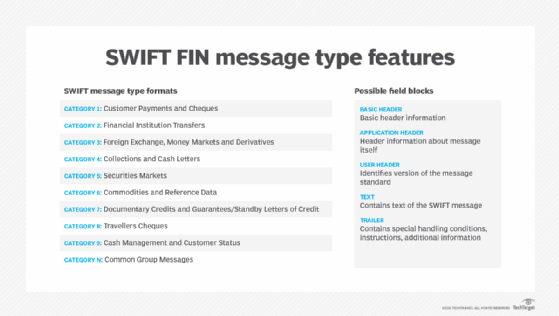SWIFT FIN message
What is SWIFT FIN?
SWIFT FIN is a message type (MT) that transmits financial information from one financial institution to another. Each SWIFT message is represented by a three-digit number. The first number identifies the category to which the message belongs, while the second and third numbers identify the message type.
SWIFT (Society for Worldwide Interbank Financial Telecommunication) is an international, member-owned cooperative that was founded in the 1970s to create a global financial messaging service. From this effort emerged FIN (financial information), a communications system that enables organizations to exchange standardized messages that adhere to specific MT formats defined by SWIFT.
What is the FIN format?
The FIN format -- or MT format -- refers to how a SWIFT message should be constructed. A message format depends on the FIN category and type. The MT standard defines the following 10 standard message categories:
- Category 1: Customer Payments and Cheques. Payment-related messages in which at least one party is not a financial institution.
- Category 2: Financial Institution Transfers. Payment-related messages in which all parties are financial institutions.
- Category 3: Foreign Exchange, Money Markets and Derivatives. Messages related to foreign exchange contracts, foreign currency option contracts, money placement or interest rate derivatives.
- Category 4: Collections and Cash Letters. Messages exchanged between banks when handling documentary and clean collections.
- Category 5: Securities Markets. Messages exchanged between financial institutions when carrying out securities
- Category 6: Commodities and Reference Data. Messages exchanged between financial institutions when carrying out commodity-based transactions.
- Category 7: Documentary Credits and Guarantees/Standby Letters of Credit. Messages exchanged between banks that participate in the documentary credit and guarantee business.
- Category 8: Travellers Cheques. Messages exchanged between issuers and agents when handling travellers cheques.
- Category 9: Cash Management and Customer Status. Messages exchanged by financial institutions to report balances, interest rate changes, netting, status or bilateral key exchange.
- Category n: Common Group messages. Message types that can be used in each of the other message categories.
The MT messaging model also includes a Category 0 for system messages that are used to exchange operational information between SWIFT and FIN interface operators.
Each category supports multiple message types. As noted above, the message type is indicated by a three-digit numerical identifier, which is always preceded by the letters MT. The first number represents the category, and the last two numbers indicate the specific message type within that category. For example, a message with the identifier MT 502 indicates that it is a Category 5 message with a 02 message type, which is used to request the sale or purchase of a particular financial instrument.
The message types are clearly defined in the SWIFT documentation. Each type has its own format specifications along with a description of the available message fields and whether they're required or optional. The documentation also provides information such as usage rules, size limitations, network validated rules, authentication requirements and other guidelines.

Although the format of a message depends on its category and type, all messages can contain five possible field blocks.
- Basic header. Contains basic header information.
- Application header. Contains header information about the message itself.
- User header. Identifies the version of the message standard.
- Text. Contains the text of the SWIFT message.
- Trailer. Contains special handling conditions, instructions or additional information.
The MT message formats were standardized in ISO 15022, which was published by the International Organization for Standardization (ISO) in 1999, with SWIFT as the registration authority. The FIN messaging system, according to SWIFT, is now used by over 11,000 financial institutions and their corporate customers, who exchange more than 30 million messages daily.
In November 2022, SWIFT will officially begin transitioning to ISO 20022, the most recent set of standards for secure messaging between financial institutions. Although ISO 20022 was introduced over 15 years ago, November 2022 marks the start of an official four-year migration period for moving from the traditional MT standards to the new ISO 20022 standards, which promise to boost efficiency, enhance the customer experience and provide richer data elements.
See also: Cyber security awareness top priority in financial sector and financial industry cloud model gains momentum








